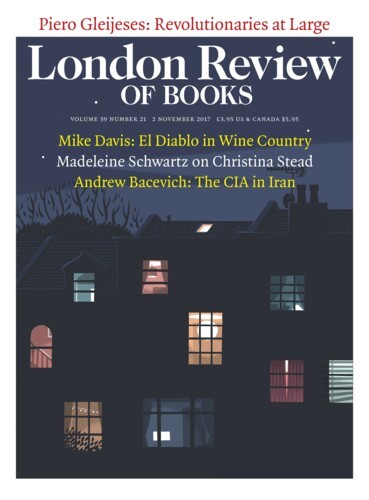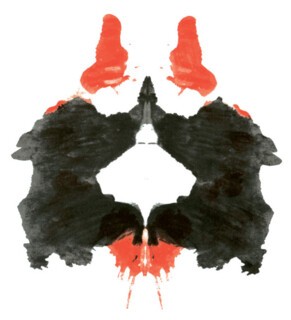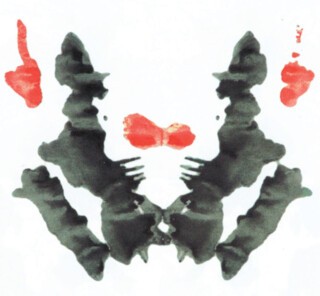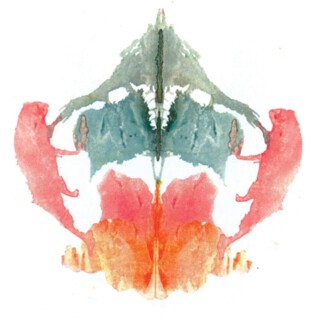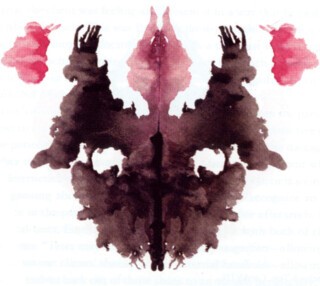Here’s what happens when you sit the Rorschach test. First you’re presented with an image that, to most people, either looks like a bat or a butterfly. Just as in the movies, you’ll be asked: ‘What might this be?’ There are ten images in total, each with its own card, and they are always presented in the same order. You can hold them in your hand and turn them around, bring them close to your eyes or look at them from a distance. You can spend as long as you like on any given card: there is no time limit.
It was once supposed to be impossible to cheat on the test – that’s why psychologists used it. The Woodworth Personal Data Sheet, the Thematic Apperception Test, Myers-Briggs: all could be out-smarted, but even the most charming psychopaths were expected to give themselves away when they started talking about the inkblots. Guides to the test had to be ‘kept secure’, and in pre-internet days, before all the cards went up on Wikipedia, the only way subjects could be sure that their answers wouldn’t signal mania or schizophrenia, inordinate anger or clinginess or depression, was by training to be Rorschachian analysts themselves. Damion Searls, whose new book offers the first history of ‘probably the ten most interpreted and analysed paintings of the 20th century’, doesn’t argue, as others have, that the Rorschach is ‘the most powerful psychometric instrument ever envisioned’, but neither does he say that it’s hogwash. He’s a literary translator, not a psychologist, and he came to the test ‘from the cultural side’. He thinks that the blots are beautiful – ‘not exactly art, but not not art either’ – and he’s interested in the modern testing industry, brought about by the Rorschach and predicated on the assumption that people are knowable, and that just by asking a few questions it’s possible to determine if someone is fit for promotion, or to be released from prison, or to lose custody of their children. The Rorschach promised a short cut to the psyche, an ‘X-ray of the soul’. People might be mysteries unto themselves, but anyone can be figured out.
Hermann Rorschach was a Swiss psychiatrist who started creating personality tests when he was bored during the First World War. In a gorgeous sanatorium by Lake Constance, he would complain to his colleagues that it was ‘the Germans’ duty to kill as many Frenchmen as possible, and the Frenchman’s duty to kill as many Germans as possible, while it’s our duty to sit here right in the middle and say “Good morning” to our schizophrenic patients every day.’ His father, Ulrich, was a painter who spent years writing a treatise on ‘the laws of form’, which he thought would apply to everything in nature, if only he could figure out what they were. His obituary in 1903 reported that he had been depressed and delusional, and that his last years were filled with ‘unspeakable torments’. His son might also have been an artist had he not discovered Tolstoy as a teenager and decided to devote himself to healing men’s souls, or at least, as he told his sister, to finding out whether ‘it wouldn’t have been possible to help Father’. At medical school in Zurich he attended Jung’s lectures and helped to found the Swiss Psychoanalytic Society, but he always resisted being analysed himself. In Searls’s telling, he’s a paragon of mental health – ‘open-hearted and sympathetic, talented but modest’ – and simply didn’t see the need. He also thought the claims for it overblown: ‘in Vienna,’ he wrote in a letter to a friend, ‘they’re going to be explaining the rotation of the earth psychoanalytically before long.’ Unhappy foreigners, particularly Russians, might benefit, but he didn’t think it would do much for the Swiss, who were lousy ‘self-observers … or self-devourers, as their saying goes’. They needed prompting. Instead of the talking cure for his sanatorium patients, he opted for art therapy. He also spent years on a study of Swiss phallic cults.
The Inkblots unfortunately doesn’t reveal how Rorschach actually designed the test: there are ‘no surviving notes or dated drafts, no letters from Rorschach to anyone between early 1917 to 1918’, the period when he was putting it together. In Rorschach’s only book, the often baffling Psychodiagnostics, he says that the test was ‘determined by empirical results’, but he doesn’t say what they were, and admits that he can ‘offer no explanation for why the test worked at all’. It seems that he tested different blot designs on a few hundred patients and some sanatorium staff, refining as he went along. Searls suspects that Rorschach created hundreds of images before settling on ten, all of them ‘hovering’ between not too particular (or everyone would see the same thing) and not too abstract (or no one would see anything but blots). They’re all symmetrical, which Rorschach thought ‘makes the form more pleasing to the eye and thus makes the subject more willing to perform the task’, as well as fair to the left-handed. A rival, Szymon Hens, who created an inkblot test a few years earlier, thought that seeing lots of different things – the more the better – was a sign of creativity, but Rorschach didn’t think that the overall number of responses was conclusive: ‘depressed, sullen or unobliging subjects’ tended to give few responses, but then so did ‘subjects ambitious to give answers of the highest quality’. Subjects ‘in good humour, those who enjoy phantasy, and subjects who are especially interested, give a larger number of interpretations’ – more than the average fifteen to thirty responses overall – but so did ‘subjects who are anxious to do well’, ‘feeble-minded subjects and epileptics’ (Rorschach thought this was because ‘they enjoy performing a task that appears easy’). Usually an assessment took twenty to thirty minutes: depressed patients took longer than ‘manics’ although they gave fewer responses, and schizophrenics were the fastest. ‘Normal’ people would give a response for every plate, while failure to answer was, very likely, a sign of schizophrenia or feeble-mindedness.
In horror movies, serial killers successfully feign harmlessness by claiming that all they see in the blots are butterflies, certainly not piles of female corpses. In the great Olivia de Havilland movie Dark Mirror – she plays good and evil twins – the test is all about Jungian archetypes. But for the actual test – this is the sentence that Rorschachians always repeat – ‘what matters isn’t what you see, but how you see.’ A few ‘content’ answers would later come to be thought significant: ‘food responses’ indicate that a person is ‘unusually dependent’ in relationships; a lot of sexual responses point to schizophrenia. But of more importance is whether an answer is judged to have ‘good form’ – ‘whether it could reasonably be said to describe the actual shape of the blot’ – as determined by Rorschach’s own sense of things, and also by responses from other ‘normal subjects’; he doesn’t say how he determined that those subjects were normal. Schizophrenics are supposed to have the worst sense of form and subjects suffering from depression the best, because ‘depression improves the sharpness of form visualisation, while elation dulls it.’ To Rorschach, the depressed suffer because their sense perception is actually too good. They’re only too aware of their own shortcomings and their responsibility for their failures, the role of luck in their successes. They’ll see a bear, a bat, a pair of legs, never a ‘tiny king from a fairy tale greeting two queens’.
‘Form’ isn’t the end of it: that would be too easy. In general, subjects who see images in motion – dancing squirrels, bowing waiters – are supposed to be the most creative, and those who focus on details are pedantic and unimaginative. The images are mostly black and white, but some cards have a little red in them, and the last three cards are psychedelic. Rorschach’s example of a ‘colour response’ – when what a subject sees is determined by colour instead of form – would be thinking that a particular red blot looks like a rose, though it didn’t seem rose-like to Rorschach. He decided that depressed subjects rarely offered colour responses, unlike ‘imbeciles’ or epileptics, although not offering any colour responses didn’t necessarily mean a subject was depressed. Rorschach reported that when subjects arrive at the first colour card after all the black and white, they ‘frequently … experience an unmistakeable shock, an emotional and associative stupor of varying length’. These subjects, Rorschach says, are neurotics who deal with strong feelings by trying to push them away. He expected healthy men to show ‘fewer colour answers than females corresponding to the greater emotional lability of the female’, but Psychodiagnostics otherwise says little about gender differences. The test was supposed to work on everyone – ‘the most primitive Negro as easily as with a cultured European’ – though possibly not on teenagers, who too often came off as insane: ‘the fourteenth year is a remarkable time of crisis,’ Rorschach wrote, and he thought that the test proved it.
The Rorschach is difficult to score – errors are common – and psychologists looking at the same responses often come to different conclusions. Even determining what distinguishes a ‘movement response’ from a ‘form response’ isn’t straightforward: you might think that ‘a dog snapping at a butterfly’ or a ‘bird in flight’ would count as movement responses, but no. A single answer is rarely dispositive, since what matters is the interplay of form, movement, colour and attention to detail: this is why it’s hard to cheat even if you know a bit about the test. A ‘manic-depressive in a depressive stage’ isn’t supposed to see moving images or respond to colour, while schizophrenics give plenty of movement and colour responses, but with a poor sense of form. When the test diagnosed a subject who otherwise displayed no symptoms as schizophrenic or manic depressive – this happened a lot – Rorschach would claim that the subject had a mental illness in a latent, otherwise undetectable form.
Although Rorschach’s papers don’t reveal the origins of the test, they’re clear about the struggle for publication: he sent ‘letter after letter, telegram after telegram to his prospective publishers and better connected colleagues’, Searls writes. A wartime paper shortage made reproducing the cards difficult, and it didn’t help that outside Switzerland leading psychologists were a little preoccupied. His book heralding a ‘diagnostic test based on perception’ finally came out in a small edition in 1921. Rorschach died less than a year later of appendicitis. He was 37.
A few of his late writings suggest that he was interested in integrating his methods with psychoanalytic theory – he told a friend that maybe it mattered after all ‘whether a patient interprets the red part of a card as an open wound or sees it as rose petals, syrups, or slices of ham’. But no one was pushing him: Psychodiagnostics was barely reviewed, and was only translated after the book ended up in the hands of an American graduate student, Samuel Beck, in need of a dissertation subject. Beck would make popularising, refining, expanding and defending the test his life’s work. Rorschach’s ten cards remained the same, but the scoring system became both more elaborate and more systematised. It benefited from the war years: the US army wanted a personality test to screen out madmen, and psychiatrists and psychologists, drafted into the military, were made to learn the techniques, then continued using them after they were demobbed.
During the test’s heyday in mid-century America, the test was used by psychiatrists to out homosexuals (supposedly gay men saw a ‘muscular male torso’ on Card I), by anthropologists to ‘gauge the character of foreign people’, and to show that women underwent psychological changes during their periods, when they had ‘more sexual answers and more anatomical answers, slower response time, more fussy Small Detail answers’. There was even a tactile version in use, so that the blind wouldn’t be left out. In a memoir, Maya Angelou mentions having to take the test before she was allowed to became a San Francisco streetcar conductor; B.F. Skinner, ‘who gave a staggering 196 responses’, was found to have a ‘contemptuous attitude towards other people’. For a while, the Rorschach was given to every new student at Sarah Lawrence College in New York, ‘with the results scanned quickly for striking problems’ – the examiners paid particular attention to responses to colour (or if ‘the number of colour responses was more than twice the sum of movement responses, or the number of movement responses was more than twice the sum of colour responses’). Anyone who thought the test was silly was told again about the freshman who had ‘seemed fine’ with a ‘lively manner’ and ‘thoroughly collegiate clothes and appearance’, whom the Rorschach had found to be ‘strikingly disturbed’. After an investigation, the college discovered that she had ‘once gone after her sister with a knife’.
Psychologists who swear by the Rorschach often say they came to it only after initial scepticism, and they have the zeal of converts. Their stories often share a similar structure: distrust followed by an instance of a single subject who had seemed unremarkable apart from some strange scores on the Rorschach, then bam!, the psychologist reads in the newspaper that the subject has disemboweled an entire Girl Scout troop. Searls’s book begins with the story of a ‘charming and friendly’ man who had applied for a ‘job working with young children’ – how could this story not end in flames? He did fine by every standard except that ‘on the Rorschach, his persona broke down’, supposedly revealing that his ‘hold on reality was extremely vulnerable’, after which the psychologist discovered that the man was a child molester: of course he was, or the anecdote wouldn’t start the book. At Nuremberg, most psychologists were in agreement that the Nazis on trial possessed a ‘certain lack of introspection, a propensity for chameleon-like flexibility in adapting to others’, but were mostly ‘average’ or even ‘particularly well adjusted’. Then the American psychologist Gustave Gilbert gave the prisoners the Rorschach. In Nuremberg Diary (1947), he describes giving Hermann Göring his results: ‘Do you remember the card with the red spot?’ Gilbert asks him.
Well, morbid neurotics often hesitate over that card and then say there’s blood on it. You hesitated, but you didn’t call it blood. You tried to flick it off with your finger, as though you thought you could wipe away the blood with a little gesture. You’ve been doing the same thing all through the trial – taking off your earphones in the courtroom, whenever the evidence of your guilt became too unbearable … You didn’t have the courage to face it. That is your guilt … you are a moral coward.
Bravo! But also: bonkers. ‘No double-blind survey would ever prove that flicking the red was a sign of genocidal moral cowardice,’ Searls writes, but it’s such a good story: more true than real, like Lady Macbeth.
The stories about the Rorschach getting it right are almost invariably about disturbed people caught out by the test, only extremely rarely about a healthy person being exonerated. There’s a reason for this: in the 1980s, a group of psychologists found that 80 per cent of ‘normal individuals’ are found by the test to have ‘depression or serious character problems’. Another study: when the Rorschach was given to aviation students and hospitalised psychiatric patients, the test results couldn’t distinguish between the two groups. The US military lost interest in the Rorschach after too many recruits were screened out, though most American clinical psychology programmes continue to teach it, and Rorschach results are still presented as evidence in American courts, particularly in child custody evaluations, and in civil trials in which plaintiffs have to demonstrate that they’re suffering from emotional distress. Estimates vary, but probably at least a few million people worldwide will take the test this year: it never quite caught on here, but it’s huge in Japan and Argentina, ‘marginal in Russia and Australia’ and ‘on the rise in Turkey’ – developments, Searls acknowledges, that all ‘have their own histories’.
Searls does point to a possible new use of the Rorschach: a small Finnish study suggests that it might be a tool to detect Alzheimer’s disease – Alzheimer’s patients seem a bit less likely to detect human figures than patients suffering from other kinds of dementia. Japanese marriage counsellors like the test too, if only as a way to get people to talk about themselves. The act of taking it can be therapeutic, though probably not any more than a regular conversation would be. Just don’t agree to do it if you’re in the middle of a divorce.
In The Cult of Personality (2004), Annie Murphy Paul looks at the long list of ineffective personality tests that followed the Rorschach: ‘The cycle, repeated endlessly, goes like this: psychologists devise a novel way of assessing personality and boldly declare it a key to human nature. The method is widely acclaimed, then, inevitably, it’s debunked; at last, it’s superseded by the next thing.’ And she points to the divergence between what academic researchers have shown (that personality tests aren’t reliable) and what psychologists keep doing in their offices (offering them). At the moment, the most popular personality test, administered in thousands of businesses, hospitals, courts and prisons all over the world, is the Minnesota Multiphasic Personality Inventory (MMPI), a long questionnaire comprised of several hundred statements, including ‘I enjoy detective or mystery stories’, ‘I am a good mixer’ and ‘My sex life is satisfactory’; subjects say whether they agree or disagree with each one. Doctors at a University of Minnesota hospital in the 1930s determined how healthy people should complete the survey by using their patients’ visiting friends and relatives as a control group – the so-called ‘Minnesota normals’, all of them white, mostly rural, overwhelmingly Protestant. ‘Soviet cosmonauts, Japanese businessmen, Holocaust survivors, serial killers, herpes sufferers, members of a snake-handling West Virginia religious sect and presidents of the United States’ – all would be considered well only if they answered the questionnaire just like the Minnesotans, the writer Anne Brataas (a Minnesotan) exulted. The test has since been revised to take in the views of non-Minnesotans, and some of the methodology has changed, though the core remains the same. Not all the statements on the MMPI have equal weight. If you’re taking it in hopes of getting a job or being released from a psychiatric hospital, I wouldn’t recommend answering ‘true’ to ‘My soul sometimes leaves my body’ or ‘false’ to ‘My mother is (or was) a good woman.’ ‘But what if your mother really wasn’t a good woman?’ I once asked someone who had administered the MMPI. The answer: ‘Too bad.’
Send Letters To:
The Editor
London Review of Books,
28 Little Russell Street
London, WC1A 2HN
letters@lrb.co.uk
Please include name, address, and a telephone number.
